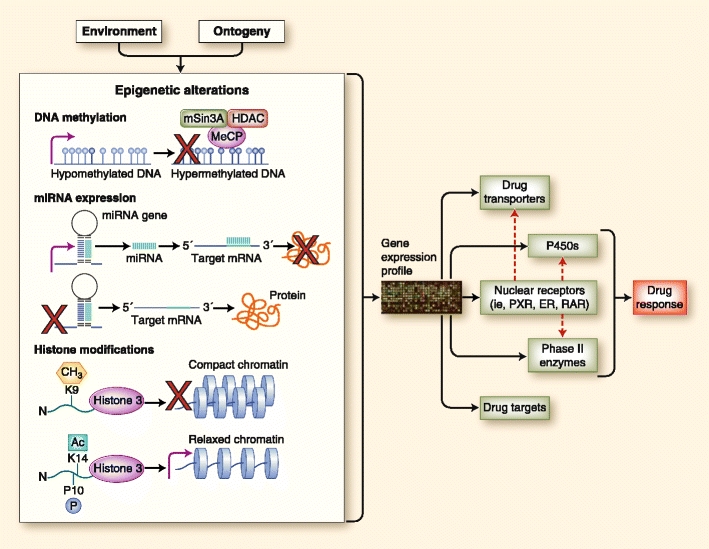Fig. 1.

Epigenetic modifications at different genetic levels and their effect on drug response. Environmental factors generate a spectrum of phenotypes in the population through the participation of epigenetic mechanisms such as covalent modification of DNA (ie, methylation) and histones and expression of regulatory noncoding RNA molecules such as microRNAs (miRNAs). Epigenetic factors affect the expression of drug transporters, drug-metabolizing enzymes, nuclear receptors that regulate the expression of various genes, and even drug targets. The dynamic state of epigenetics, as opposed to a rather established nucleotide sequence, provides the basis for an individual’s response to a constantly changing environment. Methylation of DNA provides an impediment to transcription factors and the transcription machinery by attracting proteins that affect chromatin configuration. Posttranslational modifications of the N-terminal of the histone proteins (and their various combinations) affect the compaction of the chromatin; that is, methylation of lysine at position 9 of histone 3 or H3K9me is a signature of heterochromatin or compact DNA, whereas acetylation of lysine at position 14 of histone 3 or H3K14ac—and sometimes in combination with phosphorylation of proline at position 10 of histone 3 or H3P10p—creates a more open chromatin configuration (euchromatin) that allows transcription of genes. miRNA molecules arise from miRNA genes, which, when transcribed, can promote posttranscriptional regulation by complementarity with the 3′-untranslated region of target mRNAs and their subsequent degradation. ER—estrogen receptor; HDAC—histone deacetylase inhibitor; PXR—pregnane X receptor; RAR—retinoic acid receptor. (Adapted from Gomez and Ingelman-Sundberg [35]; with permission from Macmillan Publishers Ltd: Clinical Pharmacology and Therapeutics [85:426–430], © 2009.)
